SMS marketing do’s and don’ts with the new FCC TCPA regulations

In our recent webinar, “Actionable strategies for TCPA-compliant texting and lead gen,” our Director of Professional Services, Michael Peronto, gathered experts Kristen McCormick, Head of Marketing at Hatch, and Bryan Behan, Senior Marketing Consultant at Socius Marketing, to share insights and strategies on complying with the recent changes in the Telephone Consumer Protection Act (TCPA), specifically focusing on the implications of the new one-to-one consent rule on SMS marketing.
ActiveProspect has taken strides to educate lead generation professionals about the importance of following appropriate texting channels that adhere to the new FCC TCPA updates. The potential impact this rule could bring to lead generators and marketers is expected to change the entire industry’s dynamic. So don’t wait, and don’t let it find you unprepared.
It’s time to take measures to comply with the new regulations, and we’ve gathered some helpful strategies to help you do that!
A little bit of background history of the TCPA
As Bryan says, the Telephone Consumer Protection Act (TCPA) was established in 1991 when Congress enacted the legislation and it was signed into law by President George H.W. Bush.
This law mandates that businesses must obtain explicit written consent before employing automated dialing systems for telemarketing. Over the past three decades, many companies have learned that non-compliance can lead to penalties, legal actions, and fees. In December 2023, the FCC introduced several critical amendments to these regulations that everyone should be aware of and prepare for, as they will come into effect in January 2025.
One key update is the clarification of “one-to-one consent,” which requires consumers to provide express written consent for calls and texts from each specific business they wish to hear from. This change means that lead aggregators can no longer sell leads to multiple brands unless they have one-to-one consent for all possible brands.
Additionally, the scope of the Do Not Call (DNC) list has been broadened to include cell phones, smartphones, and text messages, which were not commonly used when the law was first passed.
Another significant revision is that AI-generated phone calls will also require written consent, ensuring they are covered under the TCPA. Furthermore, calls and texts must now directly relate to the consent provided. For example, if someone fills out a form through a lead aggregator for home improvement services, they can only be contacted regarding home improvement, not real estate or any other unrelated service.
Lastly, the FCC has tightened regulations around disclosures. The requirement now is that disclosures must be clear and conspicuous, informing consumers that they may receive robocalls and robotexts from the marketer they are engaging with. This adjustment addresses previous ambiguities and enforces stricter compliance.
Things you should consider implementing now
There are several key considerations to keep in mind regarding compliance with the updated FCC rules:
- It’s crucial to ensure that your lead providers’ forms and disclosures are capturing one-to-one consent correctly. This means the disclosures must clearly specify the organization to which the consumer is giving consent.
- It’s important that your lead generator or provider is accurately recording and maintaining the consent event within their system. According to the updated FCC rules, both the buyer and the seller of the lead must have a record of the consent, necessitating the use of technologies that facilitate this documentation. Michael also suggests storing proof of consent in your CRM system and downstream data warehouses for reporting purposes.
- You should begin implementing these changes promptly and discuss with your lead providers their timeline for making these adjustments. The FCC’s ruling does not limit its applicability to leads generated only after the new rules take effect in January 2025. For example, if your legal team interprets that you can contact leads up to 90 days from submission, you would need your lead providers to implement the consent changes 90 days earlier. Therefore, initiating these discussions with your providers soon is advisable.
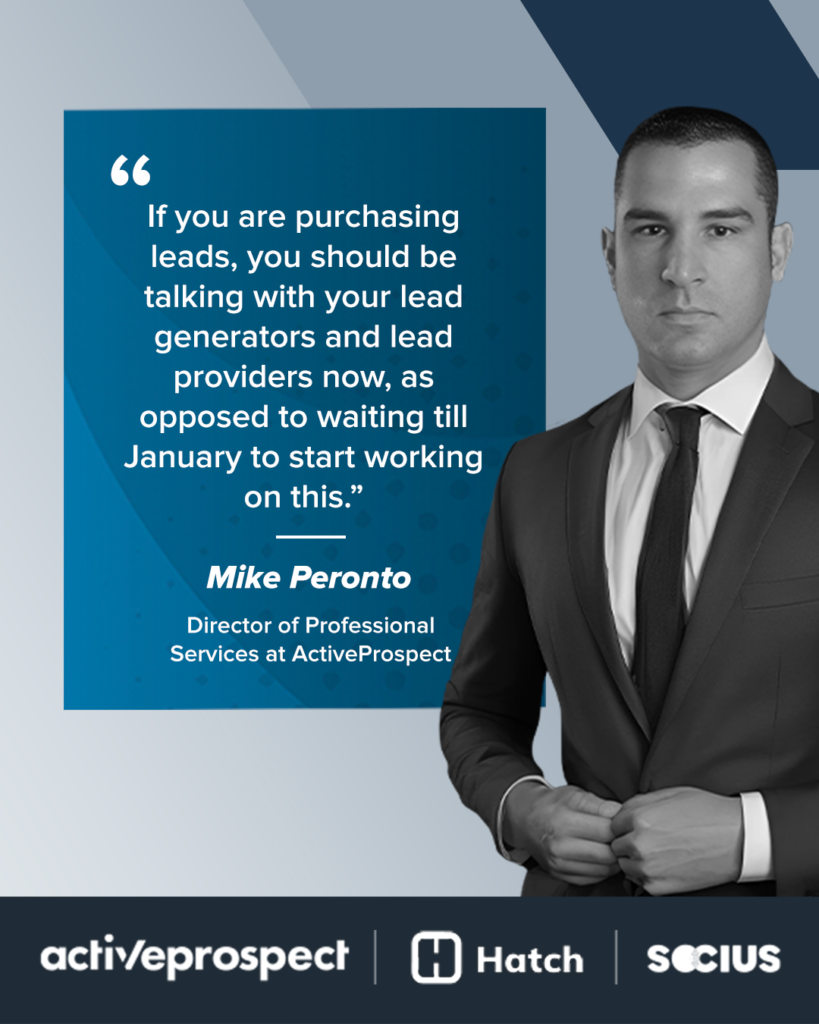
Gather and store documentation of consent with TrustedForm
ActiveProspect offers an easy and reliable solution to help both lead buyers and sellers gather and store proof of consent: TrustedForm, the ultimate compliance solution for documenting TCPA consent on digital lead capture forms.
You can start using TrustedForm Certify to create records of consent. This allows you to view a session replay that clearly shows the exact time and location where prior express written consent was obtained during a lead capture event.
After the certificate is generated, use TrustedForm Retain to make the certificate available for five years. This allows you to easily retrieve proof of consent in case you need it to address any TCPA-related legal challenges.
Begin certifying leads with TrustedForm right away! It’s simple. Just follow these steps:
- Register for a free ActiveProspect account.
- Copy the TrustedForm web SDK JavaScript snippet.
- Insert it into your web forms.

How the one-to-one consent rule is going to impact the industry
Bryan expects that the cost of leads from lead aggregators will likely increase as these aggregators adjust to new operational methods and attempt to compensate for lost revenue.
However, this could also lead to improved lead quality. With the new system, individuals filling out lead forms will specify particular brands they are interested in, creating an expectation that those selected brands will be the ones to make contact. This marks a shift from the current system where the identity of the caller is often unknown to the person filling out the form, potentially enhancing the quality of leads.
Bryan also foresees a potential advantage for larger companies that have well-established brands, more resources, and larger budgets. These companies typically have professional websites, invest in SEO to enhance organic search results, and run their own paid media campaigns, either in-house or through agencies. This comprehensive approach to lead generation, combined with their brand recognition, positions them favorably as people will likely choose familiar brands from a list provided by lead aggregators.
This scenario places smaller and medium-sized companies at a disadvantage, emphasizing the importance for these businesses to focus on building and strengthening their brand presence.
Lastly, Bryan anticipates a disruption in sales for companies heavily reliant on purchasing bulk lead lists or those excessively dependent on lead aggregators, as the new regulations will transform how leads are generated and distributed.
To this regard, Michael highlights one more change he expects to see. Under the previous system, when a consumer filled out a form and submitted it, the disclosures would mention potentially hundreds of companies to which their information could be sold. This often resulted in the consumer receiving numerous phone calls and text messages, leading to frustration. In some cases, this annoyance drove consumers to leave negative reviews online for the first company they could identify, blaming them for the barrage of communications.
Michael believes that such negative reviews will decrease under the new FCC regulations. He also thinks that the work environment will improve for employees who make calls based on shared leads, as they will be contacting consumers who are expecting their call, potentially leading to more productive and positive conversations.
How the new compliance changes are affecting SMS marketing
As Kristen explains, the TCPA has been in place since 1991, but it’s only recently been clarified that it applies to text messaging, which had been largely unregulated for a long time. Consequently, there’s been a push for corrective measures.
A few months ago, a new 10 digit long code (10DLC) registration process was introduced. Now, if you want to use a texting platform to reach your customers, you must register. This registration process helps establish evidence and reporting of an ongoing TCPA compliance chain by participants. Currently, texting providers are working with mobile carriers to secure reviews and approval for their clients. These carriers are not only vetting their websites to ensure they meet compliance standards but are also continuously checking to ensure ongoing compliance.
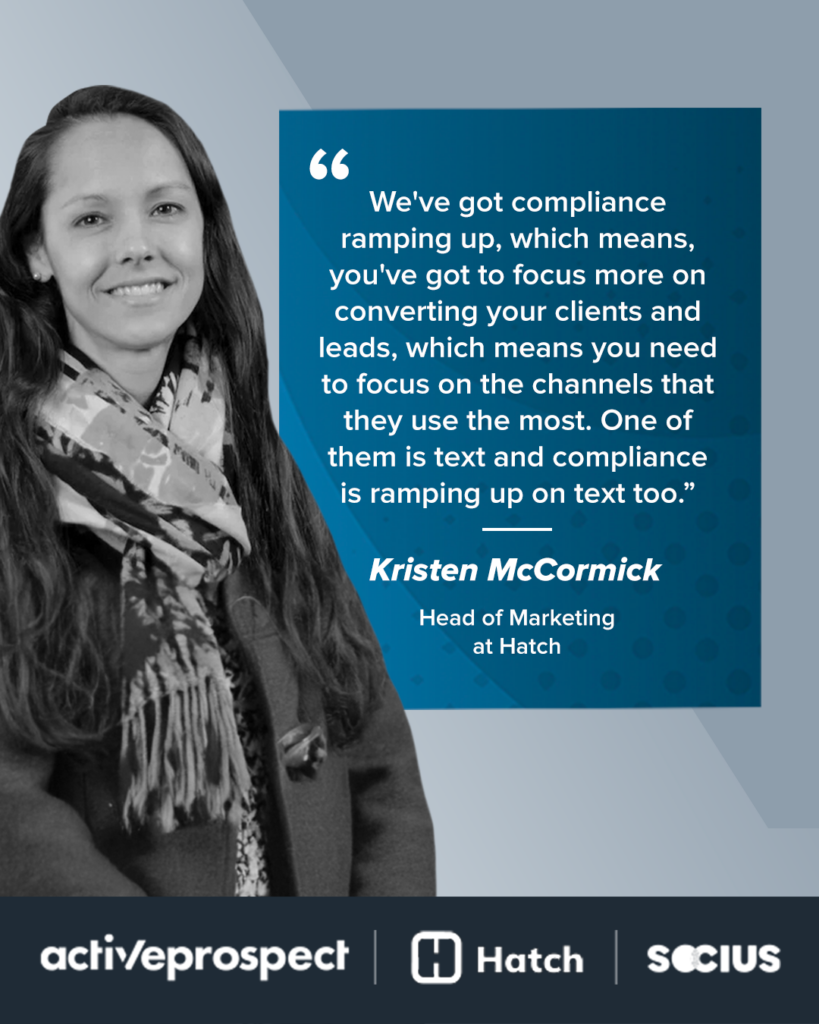
TCPA texting compliance requirements
As Kristen explains, whenever you decide to utilize a texting platform, you must register for 10DLC, which we mentioned above. During the registration process, certain elements on your website can be scrutinized, so consider:
- Should you have a dedicated SMS terms and conditions page?
- Should you include an SMS-specific section in your privacy policy?
- Are you using appropriate consent language on your web forms related to SMS?
- Are you outlining internal rules you follow for your messaging campaigns, such as purpose and frequency?
Kristen then discusses the consent language and the SMS-specific requirements.
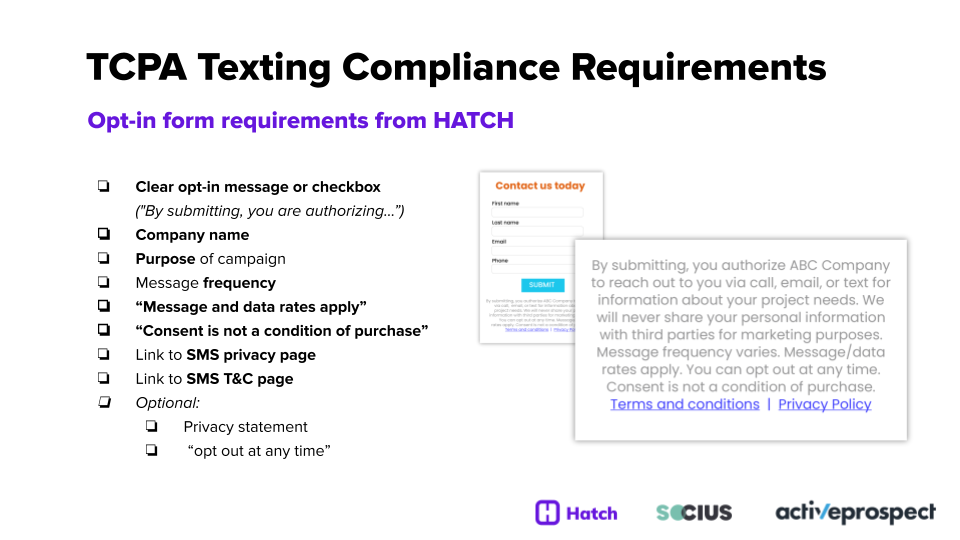
As you can see from the slide shared by Kristen, the wording on your form may not be visually appealing, but it’s now a mandatory standard that everyone must adopt. Here’s a breakdown of what needs to be included:
- Clear opt-in messaging or checkbox: If your form has a submit button, it should be accompanied by clear language such as “by clicking submit, you are authorizing [specific company name]” or “by checking this box,” making it clear and conspicuous.
- Explicit mention of SMS and your company name: The form should specify not just that “this company can contact you,” but explicitly state “via text message,” using the actual company name instead of “we.”
- Purpose of the campaign: Clearly state the reason for contact, for example, “ABC company will reach out via call, email, or text with information about your project needs.”
- Message frequency: Indicate how often messages will be sent.
- Standard messaging: Include the phrases “message and data rates apply” and “consent is not a condition of purchase.”
- Links to SMS-specific policies: Provide links to your privacy policy with SMS section, or any specific SMS terms and conditions pages. You may have a general privacy policy with a section dedicated to SMS, or a separate SMS-specific page, as long as there is a section clearly focused on SMS.
- Optional privacy statements: You can optionally include statements like “we will not sell your data” and provide information on how users can opt out at any time.
These elements are crucial, as Kristen points out, considering that actual individuals, not algorithms, are reviewing these details to vet businesses, making every detail significant.
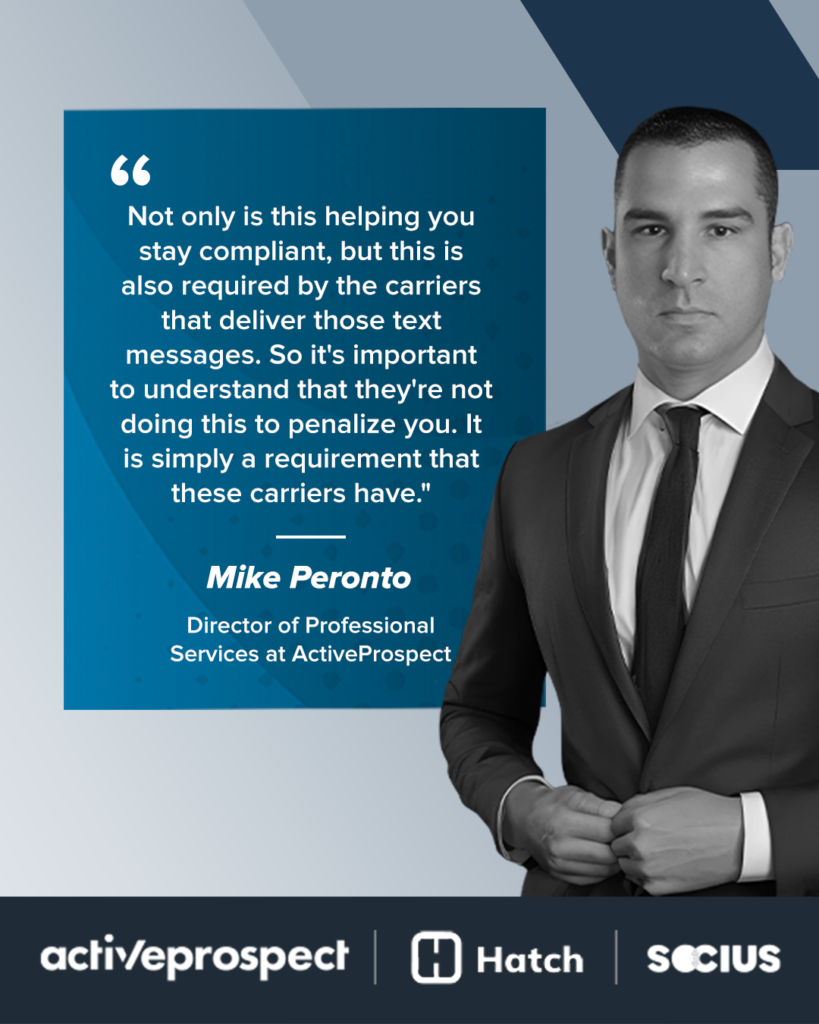
First text requirements
When you’re initiating an SMS marketing campaign, there are two primary requirements:
- The initial text message of any campaign must include your company name. This is mandatory whether it’s an automated response to a lead form submission, such as “hey, thanks for reaching out,” or any subsequent messages in a follow-up campaign. Each new campaign must restate the company name.
- The message must provide instructions for opting out. The directive “Reply STOP to stop text communication” should be included, and the word “STOP” must be in all caps. While there are several variations like unsubscribe, cancel, quit, and end, “STOP” is universally effective. For instance, if you instruct customers to reply “END” and they respond with “STOP,” the opt-out request will still be processed. It’s crucial to use all caps for these instructions.
Kristen advises paying close attention to the wording used, recommending the straightforward instruction “reply STOP to unsubscribe.”
Tips and tricks for sending text messages
We’ve discussed the essential requirements, but it’s important to understand that the rules aren’t entirely black and white; there’s no exact science to it. Kristen has observed some common reasons why messages get blocked and offers tips to improve message deliverability:
- Aim to keep your texts conversational rather than sales-oriented. People are sensitive to overly promotional content, so a more natural tone is preferable. Additionally, while it’s tempting to provide all the details to build trust, remember that one of the appeals of texting is its brevity and simplicity. Kristen suggests focusing on eliciting a response rather than making a sale. Even a reply like “I can’t talk right now” counts as engagement and can lead to further conversation.
- Keep messages brief. Although the character limit might be as high as 320, Kristen recommends aiming for no more than 150 characters to keep the message digestible. Also, avoid including different phone numbers in your texts. Messages that prompt recipients to respond to a different number than the one they were contacted from are likely to be filtered out.
- Be cautious with your language; any attempt to circumvent filters, like misspelling “stop,” can backfire. Carriers are adept at identifying such tactics, and it’s important to respect users’ desires to unsubscribe.
- Be mindful of your messaging metrics, such as message volume, opt-out rates, and delivery rates. Using the right texting platform can provide insights into whether your messages are being delivered. Some platforms set limits on how many texts can be sent per day to ensure delivery, which actually supports more personalized and effective messaging. According to Kristen, it’s crucial to choose a platform that allows you to segment and tailor your messages for smaller, more targeted campaigns.
Final thoughts
In our webinar “Actionable strategies for TCPA-compliant texting and lead gen,” we discussed the recent changes to the TCPA by the FCC and its implications on text marketing strategies.
Our expert panelists emphasized the need for businesses to ensure they are TCPA compliant when using a texting platform. This includes making sure that the disclosures on the lead forms capture one-to-one consent and that they are clear and conspicuous.
Moreover, they offered several strategies for businesses to adapt to the changes in TCPA regulations. These include investing in the business’s brand, running advertising campaigns, and focusing on organic channels to generate leads. They also advised businesses to be mindful of their SMS messaging, keeping it short and personalized, and being aware of their message volume and opt-out rate.
As always, ActiveProspect is here to help you navigate the intricacies of the new TCPA regulations by sharing knowledge and thought leadership. Never miss a TCPA update: Watch the entire episode and subscribe to our FCC webinar series now!
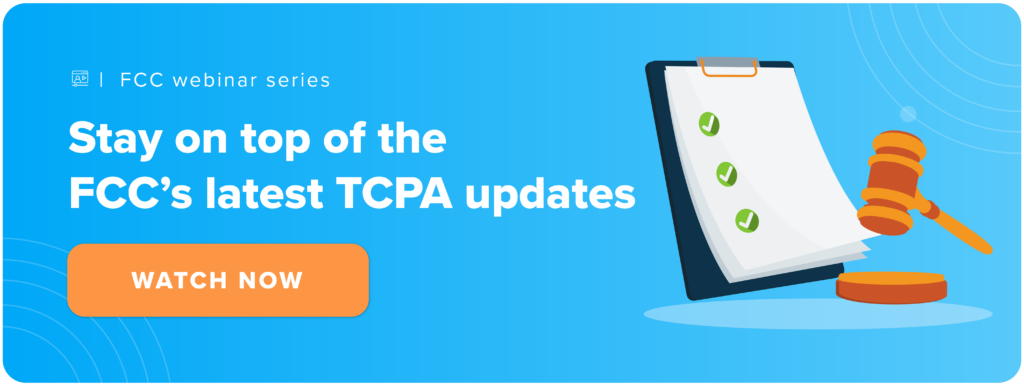
DISCLAIMER: This page and all related links are provided for general informational and educational purposes only and are not legal advice. ActiveProspect does not warrant or guarantee this information will provide you with legal protection or compliance. Please consult with your legal counsel for legal and compliance advice. You are responsible for using any ActiveProspect Services in a legally compliant manner pursuant to ActiveProspect’s Terms of Service. Any quotes contained herein belong to the person(s) quoted and do not necessarily represent the views and/or opinions of ActiveProspect.





